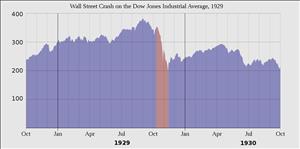On October 23, 1929, stocks are sold off in a run. Seattle stock investors become tense and nervous when they pick up and read the front-page headline on the following morning: "3 BILLIONS IN VALUES WIPED FROM MARKET."
Shock Waves
The newspaper summarized the previous day's heavy sell-off on the New York Stock Exchange:
"1) Bear raid throws market into a frenzy closely approaching panic.
2) Three billion dollars in paper values wiped out in one hour of trading.
3) New low levels for year reached by many leading (railroad) lines.
4) Pandemonium rules on [ex]change floor" (Seattle Post-Intelligencer).
October 23 witnessed more than six million stocks sold, which at the time was the second largest volume ever on the New York Stock Exchange. (Although this would not appear a substantial volume in today's market, it was enough then to set off shockwaves.)
Near the end of the trading day "virtual panicky conditions prevailed."
"The last fifty minutes of trading, when prices were fading a point [i.e., $1] or more on a single transaction, witnessed the greatest volume of business the exchange has handled [until that time]. More than 2,592,000 shares were thrown overboard without consideration and prices simply melted away" (Seattle Post-Intelligencer).
In Seattle "offices here containing quotation boards showing New York stocks were thronged" and "many hundreds of serious faces kept eyes riveted on the boards while markers were scoring more than fifty new lows" (Seattle Post-Intelligencer).
Investors Nervous
For more than five years the stock market had been in boom times. From 1925 to 1929 stocks doubled in price and reached their high mark when, on September 3, 1929, the Dow Jones 30 Industrials reached 381.18.
Then stocks started dropping in price, which most analysts at the time believed was a technical adjustment to the stock market. When the New York Stock Exchange closed on October 23, the Dow Jones had lost 75 points. Investors started to get nervous.

